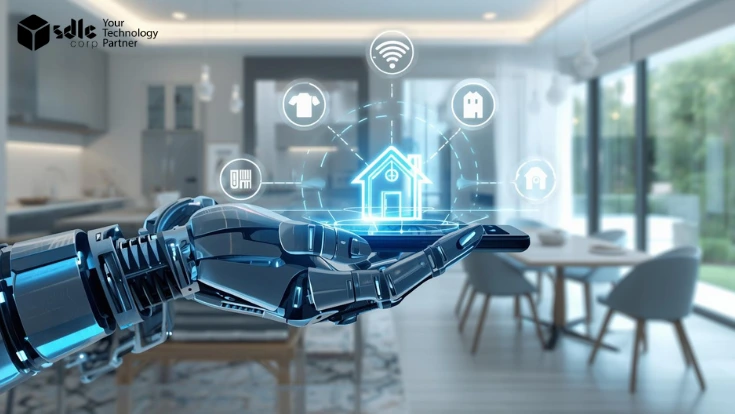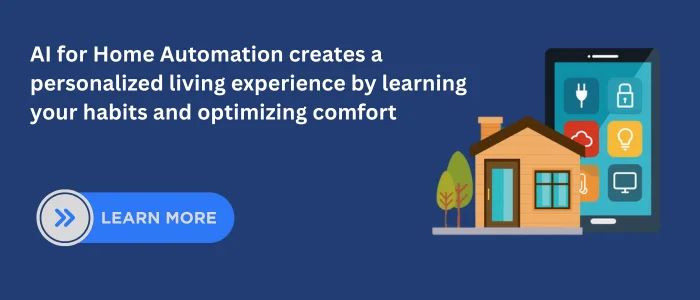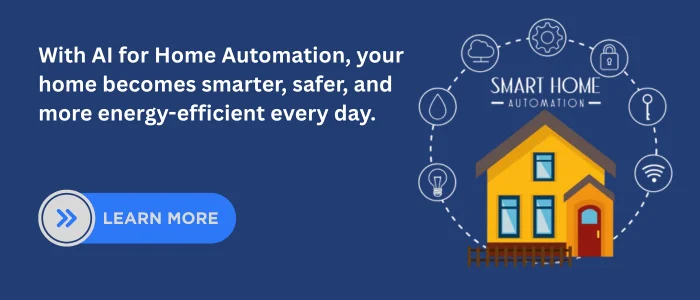Introduction
Modern households face rising energy costs, complex security demands, and the need for greater convenience. Traditional automation provides only partial solutions, but AI for Home Automation is transforming how we live. By embedding intelligence into everyday devices, AI delivers smarter energy use, stronger home security, and seamless convenience.
The global smart home market is projected to exceed $135 billion by 2025, with much of this growth powered by AI-driven smart home technology. From learning user habits to predicting needs, AI turns connected homes into truly intelligent living spaces. This article explores how AI for Home Automation is reshaping energy management, home security, and voice-controlled assistants making intelligent living the new standard. Learn more about our AI Development Services.
1. What is AI for Home Automation and Why AI-Powered Smart Homes Matter
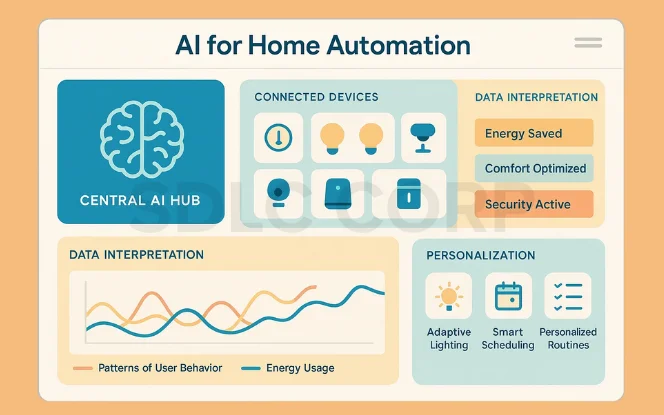
At its core, AI for home automation acts as the decision-making brain for IoT-connected homes. While sensors and devices collect data, AI interprets that information, predicts user behavior, and executes actions automatically. This makes everyday living more efficient, secure, and personalized.
Explore More : Generative AI for Home Automation
How AI for Home Automation Works in Connected Homes
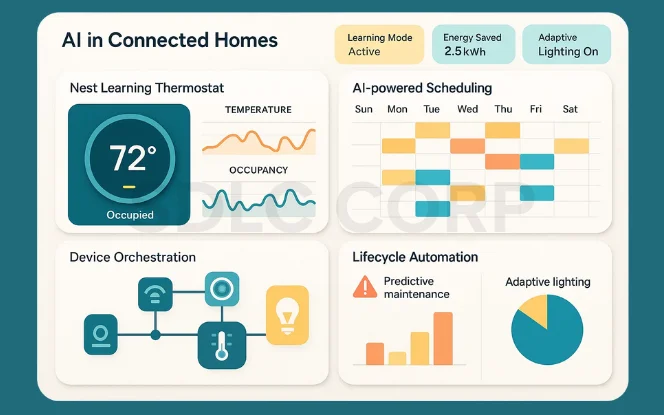
Unlike standard automation, which relies on static rules, AI uses learning models to adapt dynamically. For example:
- Nest Learning Thermostat → It studies occupancy patterns and temperature preferences. Over time, it adjusts heating and cooling automatically, saving energy while keeping residents comfortable.
- AI-powered scheduling → Systems manage routines such as lighting, appliance usage, and energy consumption at optimal times.
- Intelligent device orchestration → AI connects diverse devices—cameras, speakers, thermostats—into a single ecosystem where they work together seamlessly.
- Lifecycle automation → Homes evolve as needs change, from predictive maintenance alerts to adaptive lighting based on lifestyle shifts.
Because of these capabilities, AI transforms homes from reactive environments into predictive, intelligent spaces.
Why It Matters for Homeowners and Professionals
The importance of AI extends beyond convenience:
- For homeowners, it means lower utility bills, enhanced security, and comfort that adjusts automatically.
- For professionals, it enables scalable integration, better energy management solutions, and future-ready smart home ecosystems.
Looking ahead, experts project that by 2030, 70% of homes will integrate AI-powered scheduling and lifecycle automation. This signals a clear shift: AI is not just enhancing devices it is redefining how homes operate, interact, and adapt.
Ultimately, AI for home automation matters because it aligns technology with human needs, creating environments that are efficient, secure, and intelligently responsive.
2. Key Benefits of AI for Home Automation in Smart Living
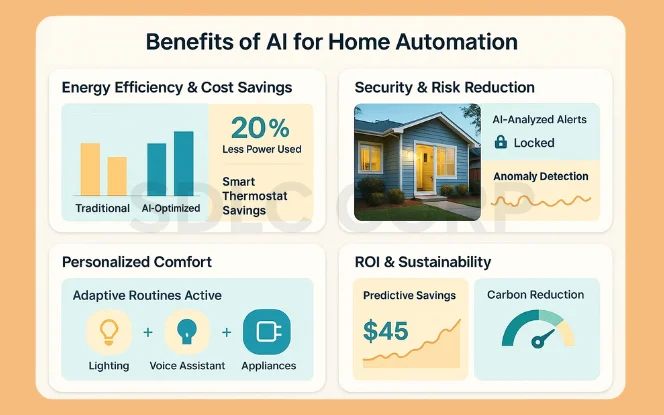
The integration of AI for Smart Cities generates tangible advantages across governance, mobility, sustainability, and citizen experience. By analyzing real-time data and automating decisions, AI systems transform traditional urban infrastructure into adaptive, efficient, and resilient ecosystems. Below are the major benefits that highlight how AI-powered city infrastructure reshapes modern living
How AI for Home Automation Improves Energy Efficiency & Cost Savings
Energy consumption is one of the most pressing household concerns. With smart AI devices, homes achieve greater efficiency by:
- Smart lighting systems that automatically dim or switch off unused fixtures, reducing household power use by up to 20%.
- AI-powered thermostats that learn occupancy patterns and cut unnecessary heating or cooling.
- Predictive appliance scheduling that shifts heavy use, such as laundry or dishwashing, to off-peak times.
As a result, families save on monthly bills while reducing their carbon footprint.
AI for Home Automation in Security & Risk Reduction
Safety is another critical benefit of AI-driven homes. For instance, AI-enabled cameras lower false alerts by as much as 40% by distinguishing between real threats and harmless activity.
- Real-time anomaly detection improves incident response.
- Automated locks and monitoring prevent intrusions.
- Predictive alerts notify homeowners of unusual patterns before risks escalate.
Therefore, AI strengthens security without overwhelming users with unnecessary notifications.
AI for Home Automation for Comfort, Personalization & Convenience
Beyond efficiency and safety, AI enables home personalization at scale. Imagine a family that automates daily routines:
- Lights adjusting automatically in the evening.
- Voice assistants preparing to-do lists and reminders.
- Appliances pre-programmed to match lifestyle patterns.
In one case, a household reported saving hours weekly by relying on AI routines that adapt seamlessly.
Long-Term ROI & Sustainability with AI for Home Automation
AI benefits extend to financial planning. Predictive ROI dashboards for homes measure savings from energy use, track device performance, and forecast long-term returns. In addition, AI-driven sustainability ensures households contribute to greener communities.
Ultimately, AI for home automation offers a compelling mix of comfort, cost savings, and security—backed by measurable results.
3. Key AI for Home Automation Workflows in Smart Homes
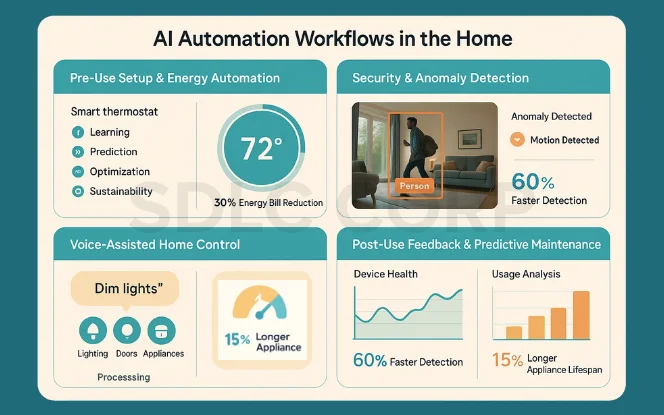
Artificial intelligence transforms the home environment by embedding automation into daily workflows. Each phase setup, real-time operations, voice control, and post-use analysis adds measurable value. The following breakdown illustrates how AI-powered home automation works step by step, with clear impacts on efficiency, safety, and comfort.
AI for Home Automation in Energy Optimization & Setup
The foundation of an intelligent home is energy management. An AI-powered energy optimization system such as a smart thermostat follows a structured process:
- Learning phase → The thermostat observes occupancy patterns, preferred temperature ranges, and seasonal adjustments.
- Prediction phase → Based on past data, the system anticipates when residents are likely to be home and adjusts settings accordingly.
- Optimization phase → Energy-intensive cycles are scheduled during off-peak hours to maximize cost savings.
- Sustainability phase → Data is analyzed to reduce unnecessary usage, lowering the carbon footprint.
Impact: Homeowners who deploy AI thermostats report up to a 30% reduction in energy bills within a year.
Technology Professionals and Businesses
Home security depends on speed and accuracy. AI-powered security monitoring systems integrate anomaly detection and predictive analytics.
- Continuous monitoring → Cameras and sensors capture environmental data.
- Anomaly detection → Algorithms distinguish between normal household activity and potential intrusions.
- Automated alerts → Homeowners receive instant notifications with verified threat levels.
- Preventive action → Smart locks or alarms are triggered automatically.
Impact: Studies show AI systems enable 60% faster intrusion detection compared to legacy systems, while also cutting false alarms significantly.
AI Voice-Assisted Home Automation Workflows
Accessibility and convenience increase with AI voice-powered home systems. Using natural language processing (NLP), these platforms bridge human commands and device orchestration.
- Input recognition → The system receives spoken commands such as “dim the living room lights” or “lock the front door.”
- NLP processing → AI interprets intent, differentiating between tasks, and prioritizing commands.
- Device orchestration → Multiple devices—from lighting to appliances—are coordinated instantly.
- Adaptive learning → Over time, the assistant refines responses based on personal habits.
Impact: Voice-powered systems improve daily accessibility, with surveys noting that 25% of elderly homeowners report greater independence through voice-assisted automation.
AI for Home Automation with Predictive Maintenance & Feedback Loops
The final workflow stage ensures long-term performance and reliability. AI applies feedback loops and predictive analytics to keep systems efficient.
- Usage analysis → Devices collect data on frequency and intensity of use.
- NLP interpretation → AI reads feedback from mobile apps, user commands, or surveys to identify issues.
- Upgrade suggestions → Based on trends, the system recommends software updates or efficiency improvements.
- Predictive maintenance → AI anticipates appliance wear and suggests proactive servicing.
Impact: Predictive systems extend appliance lifespans by up to 15%, reducing replacement costs and minimizing downtime.
Why Workflows Matter
Together, these workflows demonstrate how intelligent home automation extends beyond convenience. From AI-powered energy optimization to AI-powered security monitoring, and from AI voice-powered home systems to predictive maintenance, every stage adds measurable value. Transitioning through these workflows creates a self-improving home ecosystem one that saves money, reduces risks, and adapts continuously to household needs.
4. How to Choose the Right AI for Home Automation Platform
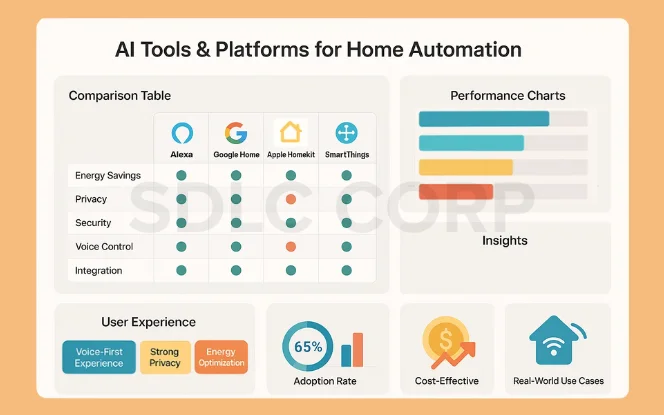
The market for home automation software is expanding rapidly, giving homeowners access to intelligent platforms that optimize energy, security, and convenience. Choosing the right system depends on individual priorities whether it’s energy savings, privacy, or voice-first experiences. To help, the following comparison highlights the best AI smart platforms currently shaping connected living.
Comparison of Leading AI Platforms
| Platform | Features | Pros | Cons | Best For |
|---|---|---|---|---|
| Google Nest | Adaptive HVAC, predictive energy use | Easy UI, accurate insights | Costly upfront | Energy-focused homes |
| Amazon Alexa | Voice AI, customizable routines | Broad ecosystem, flexible | Privacy concerns | Voice-first automation setups |
| Apple HomeKit | Privacy-centric design, device synergy | Secure, seamless for Apple users | Limited device compatibility | Apple households |
| Samsung SmartThings | Wide device orchestration, automation | Multi-brand support | Setup complexity | All-round integration |
How to Choose the Right Platform
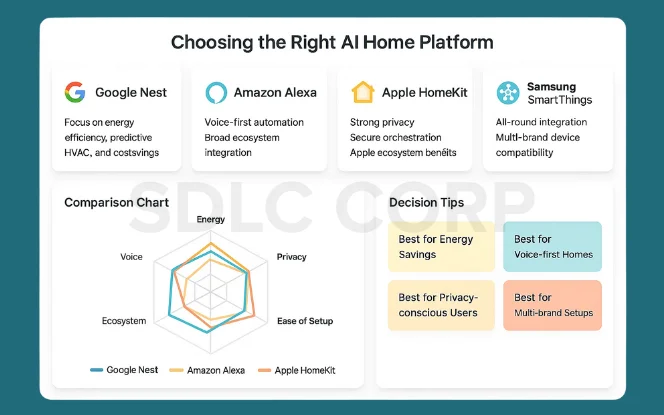
When comparing these AI device ecosystems, consider:
- Google Nest → Ideal for energy-focused homes where predictive HVAC and optimization drive cost savings.
- Amazon Alexa → Best for families who want versatile voice-first automation and integration with a broad ecosystem of devices.
- Apple HomeKit → Perfect for households already in the Apple ecosystem, offering strong privacy and secure orchestration.
- Samsung SmartThings → Suited to those seeking all-round integration with multi-brand devices, despite a more complex setup.
Why This Matters
Selecting the right AI platform is not just about convenience it defines the future scalability of a connected home. The best AI smart platforms act as long-term hubs, enabling predictive energy use, seamless security monitoring, and adaptive personalization. By aligning the choice of system with household needs, homeowners ensure that their AI device ecosystems deliver measurable value over time.
5. Best Practices for Adopting AI for Home Automation in Smart Homes
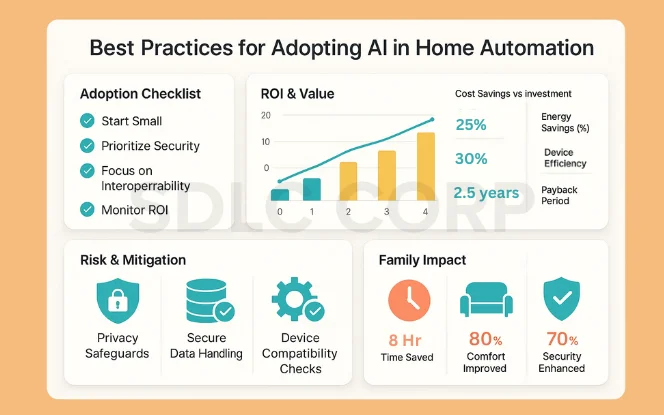
Bringing AI into the home should be deliberate, strategic, and practical. A strong AI adoption strategy helps families avoid costly mistakes while ensuring that every device delivers measurable value.
Why Pilot Projects Accelerate AI for Home Automation Adoption
Starting small reduces risk and builds confidence. For example, one household piloted AI-powered smart locks before scaling. The result was striking—full adoption across the home accelerated 20% faster compared to families that tried to automate everything at once. This demonstrates that pilots create both trust and momentum.
Practical Adoption Framework for AI in Home Automation
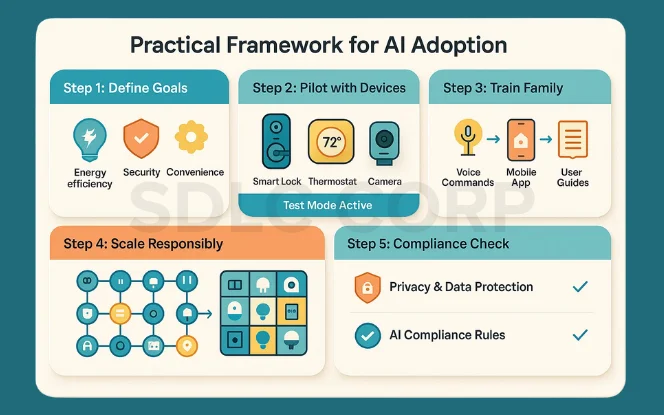
To make AI adoption smooth, families can follow a clear step-by-step roadmap:
- Define home goals → Decide if the priority is energy efficiency, stronger security, or daily convenience.
- Pilot with 1–2 devices → Test automation with limited tools such as smart locks, thermostats, or cameras.
- Train family members → Ensure everyone understands voice commands, mobile apps, and usage protocols.
- Scale responsibly → Add more devices gradually, ensuring they integrate seamlessly.
- Check compliance → Verify that platforms follow smart home AI compliance rules on privacy and data handling.
Why It Matters
A phased approach prevents overwhelm, reduces costs, and ensures every household member benefits from automation. Moreover, training and compliance checks reduce security risks while boosting long-term satisfaction.
Ultimately, the best AI adoption strategy is not about rushing into full automation it’s about aligning smart tools with lifestyle needs, building trust through pilots, and scaling responsibly. By doing so, homeowners can future-proof their spaces while enjoying comfort, efficiency, and peace of mind.
6. Challenges & Ethical Considerations in AI for Home Automation
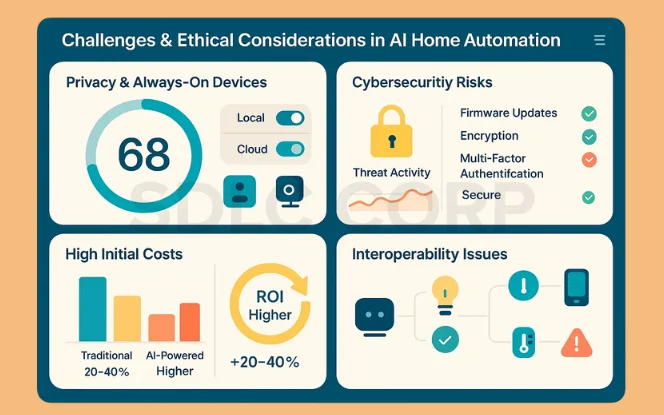
While AI-powered home automation offers convenience, efficiency, and comfort, it also presents significant challenges. Addressing these risks openly is critical to building homeowner trust and ensuring safe, ethical adoption.
Read Also : Generative AI for Real Estate Startups
Privacy & Always-On Devices
Smart speakers, cameras, and sensors are often “always listening” or “always watching.” This creates legitimate privacy concerns for families who want convenience without compromising confidentiality.
- For instance, in 2022, Consumer Reports revealed that 59% of smart speaker owners were concerned about how their voice data was stored and used.
- Data collected by voice assistants may be sent to the cloud, where breaches or misuse become possible.
Impact: Homeowners demand ethical AI devices with clear consent policies, local data processing options, and transparent storage practices.
Cybersecurity & Hacking Risks
The very connectivity that makes AI powerful also exposes households to cyber threats.
- A Kaspersky report documented smart lock hacks where poorly secured systems were bypassed within minutes.
- Vulnerabilities in Wi-Fi-enabled devices can open gateways to entire home networks.
Mitigation strategies include:
- Regular firmware and security updates.
- End-to-end encrypted communication.
- Multi-factor authentication for critical devices.
Impact: Stronger security protocols reduce AI risks in homes while preserving the benefits of automation.
High Initial Costs & Adoption Barriers
Although smart devices often lower operating costs long-term, upfront investments remain a major barrier.
- AI-powered thermostats, locks, and cameras can cost 20–40% more than traditional devices, according to Statista.
- For many households, the ROI must be clear before adoption feels worthwhile.
Impact: Transparent pricing models, bundled ecosystems, and financing options can accelerate adoption.
Interoperability & Legacy Devices
Smart ecosystems often struggle to integrate with older appliances.
- A homeowner may buy an AI hub only to discover it won’t sync with legacy lighting or outdated HVAC systems.
- Lack of open standards leads to frustration and higher long-term costs.
Impact: Cross-platform compatibility and interoperability standards are essential for truly scalable home automation.
7.Future Trends of AI for Home Automation and Smart Homes
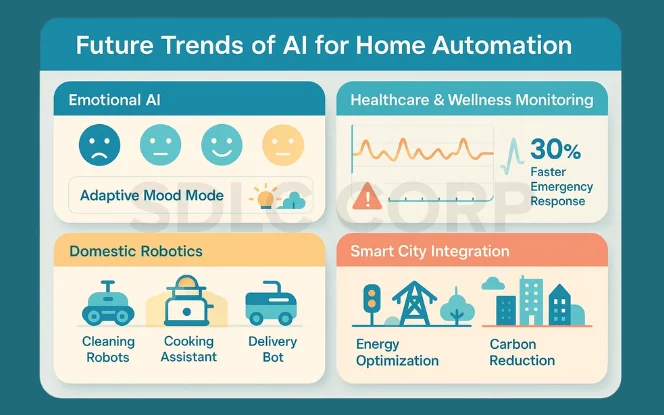
The next wave of AI home trends 2025 points toward deeper personalization, health-focused systems, and seamless integration with broader smart ecosystems. As homes evolve into intelligent environments, the role of AI will expand beyond efficiency into empathy, wellness, and sustainability.
Emotional AI for Personalized Home Automation
Future smart homes will adapt not only to behavior but also to emotions. Emotional AI will analyze voice tone, facial expressions, and daily patterns to adjust lighting, temperature, and entertainment. For example, a home could detect stress and automatically create a calming environment. This level of personalization transforms sustainable AI homes into empathetic companions.
Read About : Generative AI for Healthcare
AI for Home Automation in Healthcare & Wellness
AI will increasingly serve as a wellness partner. From continuous health monitoring to fall detection, smart devices will provide early alerts and connect directly to healthcare providers. PwC predicts, “AI-driven health monitoring will reduce emergency response times by 30% by the end of the decade.” For elderly homeowners, this innovation enhances independence and safety.
AI Robotics in Daily Home Automation Workflows
Domestic robotics will extend AI’s capabilities into physical assistance. Cleaning, cooking support, and delivery of household items will be managed by AI-enabled robots. These devices will connect with the AI device ecosystems already in place, creating a seamless layer of automation across digital and physical spaces.
Integration with Smart Cities
AI for Home Automation is transforming homes into intelligent ecosystems that are efficient, safe, and highly personalized. By leveraging machine learning and predictive analytics, these systems optimize energy use, enhance security, and adapt to daily routines seamlessly. Smart thermostats, voice assistants, and AI-powered security tools illustrate how technology can anticipate needs and deliver convenience without waste. As adoption grows, homes will become more connected, sustainable, and proactive in delivering comfort. Embracing AI-powered systems today ensures your home is not only modern but also future-ready—designed to think, learn, and evolve alongside your lifestyle.
Conclusion
AI for Home Automation is transforming homes into intelligent ecosystems that are efficient, safe, and highly personalized. By harnessing machine learning and predictive analytics, these systems optimize energy consumption, strengthen home security, and adapt seamlessly to daily routines. From smart thermostats and voice assistants to AI-powered security solutions, technology now anticipates needs and delivers convenience without unnecessary waste.
As adoption grows, smart homes are becoming more connected, sustainable, and proactive in delivering comfort. Embracing AI-powered home automation today ensures your living space is not only modern but also future-readydesigned to think, learn, and evolve alongside your lifestyle. Discover more through our AI Development Solutions for Home Automation .
FAQs
1. What is AI For Home Automation?
AI for Home Automation refers to the integration of artificial intelligence into smart home systems. These systems use machine learning and IoT data to analyze user behavior, predict needs, and automate household functions.
2. How Does AI Improve Energy Efficiency?
AI-enabled devices, such as adaptive thermostats and smart lighting, monitor patterns in energy consumption. They optimize usage by adjusting temperature, lighting, or appliance cycles in real time, reducing waste without sacrificing comfort.
3. What Are The Risks of AI In Home Automation?
AI supports sustainability by optimizing resource allocation, managing smart grids, reducing energy waste, and enabling predictive maintenance of infrastructure. In this way, AI for Smart Cities aligns urban development with climate goals.
4. What Is The Future Of AI-powered Homes?
The future of intelligent home systems lies in predictive automation, full IoT integration, and sustainable living. AI will evolve to create homes that are proactive, self-optimizing, and more aligned with human lifestyles.
5. Can AI-powered systems be integrated gradually?
Yes. Homeowners can begin with individual AI smart devices such as voice assistants or thermostats and expand step by step into a complete automated home intelligence ecosystem.

